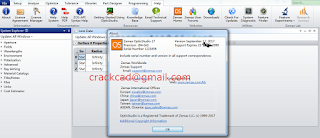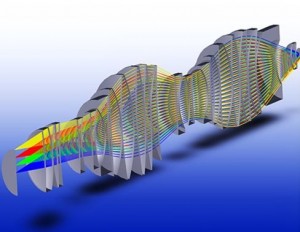

Here, we are limiting ourselves to the height and the radius of the rod for the sweep parameters. To decide on a design that meets the above requirements, it might be necessary to consider the effect of other parameters such as height, period, and refractive index as well. It is desirable to have a high transmission regardless of the radius of the nanorod. In this example, we are interested in a hyperbolic lens with a phase change of 2π over the length of the metalens radius (note this is different from the nanorod radius). In many cases, there are certain requirements the metalens must meet such as the desired phase profile and the transmission level. It was shown that the phase of the nanorod array can be controlled by changing its radius. Step 2: Unit cell (Sweep height and radius)

This modification of the effective path length of the incident light by changing the nanorod radius is one of the key properties utilized in this example. As can be seen from the images below, the real(Ex) for the larger radius indeed shows a shorter period, meaning a higher effective index. Generally, a larger radius will result in a higher effective index along the propagation direction (z-axis). The respective effective indices experienced by the incident field are different for the two cases. The script also creates two images of the field profiles for nanorods with different radii. If desired, the agreement can be further improved by refining the mesh. Note the good agreement between the two results. Then, the phase is calculated analytically and plotted together with the result from the analysis group. The script disables the structures (“substrate” and “pillar”) and sets the wavelengths range.

zbf format for further analysis in Zemax. The design is verified through near- and far-field analyses.
ZEMAX DOWNLOAD FULL
Step 3: Full lens simulationĬonstruct the full metalens based on the target phase profile and the phase vs.

radius result at the selected height is saved for the next step. The height that gives the desired transmission and phase properties is chosen. Sweep the height and radius of the nanorod and obtain the transmission and phase. Step 2: Unit cell simulations (Sweep height and radius) As we will be using the s-parameter analysis group for the calculation of the phase, this initial step will serve as a sanity check to ensure correct settings for the analysis group. The key result that we are interested in is the phase of the field above the nanorod in response to a plane wave. The example starts with a unit cell simulation of a periodic 2D array of nanorods. Step 1: Unit cell simulations (Initial check) With the knowledge of the phase in terms of the geometry parameters, it is possible to create a metalens with an arbitrary phase profile. By adjusting the geometry of this unit cell element, one can modify the phase above the element in response to a plane wave. Metalenses consist of carefully arranged "unit cells" or "meta-atoms" with sub-wavelength structures. Understand the simulation workflow and key results
ZEMAX DOWNLOAD LICENSE
] An OpticStudio version +12 and the Zemax Interoperability license are required for further analysis in Zemax Further propagation analysis is performed in Zemax using the exported near-field result from Lumerical. The design is verified in FDTD Solutions through near- and far-field analyses. The radius and the arrangement of the nanorods are tailored to create a desired phase profile on the metalens surface. The goal of this example is to design a diffractive metalens consisting of cylindrical nanorods.


 0 kommentar(er)
0 kommentar(er)
